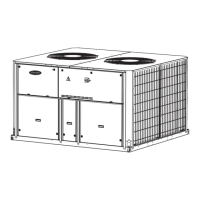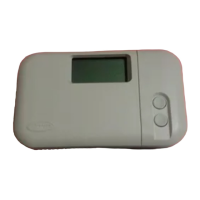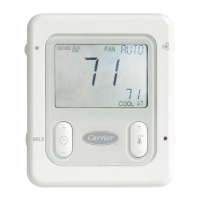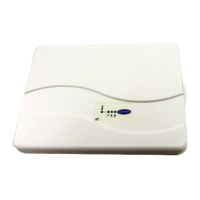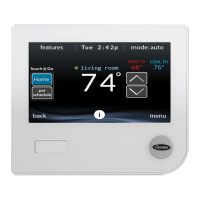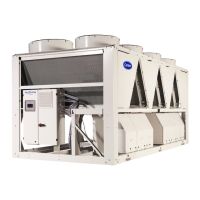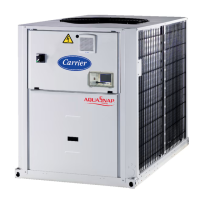The zone controller can be configured for one of three types
of air terminal control - single duct, series fan or parallel fan. If
configured for parallel fan, the fan will be energized whenever
the there is a demand for heat the system mode is not Heating
and when there is a demand for heat when the zone is unoccu-
pied and the system mode is not Heating. If configured for
series fan, the fan will be energized whenever the zone is
occupied and when the there is a demand for heat when it is
unoccupied. To prevent all series ftm zones fiom starting tit one
time, the zone controller will run a start delay algorithm based
on the zone controllers address to stagger the fan stm't time.
Before starting the fan is started the zone dmnper will go to the
fully closed position to prevent the fan from stm'ting back-
wards. The following formula is used to delay the fan start in
second:
Delay time in seconds = (((Whole Remainder of Element#/
20)*60)+20)
ZONE DAMPER TEMPERATURE CONTROL --The damp-
er will modulate to adjust the airflow to the space to mtfintain
its current set point. The damper is controlled by a PID loop to
provide plecise control of the damper position. The damper
will be modulated opened if the system mode and local mode
are the stone. As the zone temperature gets closer to the set
point, the damper will modulate to the Minimum Dmnper
Position. The amount the damper will be open at any given
time depends on how far away the temperature is from the set
point, how fast it takes to satisfy the mode, and the Minimum
and Maximum Positions for current mode. Once the zone is
satisfied the damper will go to its Minimum Damper Position
for that mode. Cool/Heat Minimum and Maximum Positions
me defined in the Damper selwice configuration table.
If the local zone temperatme is different fiom the system
mode then the damper will be at Minimum Position for the
system mode.
ZONE DAMPER REHEAT-- If the zone controller has
optional reheat instt_lled, it will use this heat to maintain the
heating set point. There am 4 types of heat options available as
listed below:
• Modulating hot water or steam (requires a supply air
temperature [SATI sensor for ducted heat or a leaving
water temperature sensor for baseboard heat)
• Two-position hot water or steam (SAT required)
• 1 to 3 stages of electric heat (SAT required)
• Combination of staged baseboard and ducted heat (SAT
required)
If the zone controller is configured for single duct terminal,
the system mode is cooling, and the zone local mode is heating
the damper will go to the configured Reheat Minimum Position
or the Cool Minimum Damper Position (as configured in the
Damper service configuration table) whichever is greatel: and
reheat will be energized.
If the zone controller is configured for series or parallel fan
terminal the zone controller will close the dmnper to the Cool
Minimum Position before energizing the reheat. For parallel
zone termimds the fan will be energized as the first stage of
heat. The zone controller uses a PID algorithm to calculate a
supply air or leaving water temperature, which the reheat will
be controlled to, in order to satisfy the heat demand.
If the system mode is Heating, the zone controller will try to
heat the zone with the central heat but may energize leheat to
satisfy the demand if it is required. If the terminal type is con-
figured for pm'allel fan the fan will lem_in off. If no reheat
is desired in the zone while central heat is on or under any
other specific conditions, it can be disabled by forcing the Heat
point in the Status Display table to Disable. Contact your local
Cturier Controls representative if you need assistance with this
application.
ZONE DAMPER VENTILATION -- After the zone has sat-
isfied and the system mode is Cooling or Free Cooling and the
SAT is between 65 and 75 E the damper will go to its Ventila-
tion Position or the Cool Minimum Position, whichever is
greatel: If the SAT is less then 65 or greater then 75 or the
system mode changes to Heating, the damper go to the current
system mode Minimum Position. The Ventilation Damper
Position is defined in the Dmnper service configuration table.
DEMAND CONTROL VENTILATION (DCV) --If the zone
controller has a CO 2 Demand Ventilation sensor it will be able
to override the temperature controlled dmnper position if it is
occupied, the system mode is Cooling or Free Cool, and the
zone is does not have a demand for heat. When the IAQ sensor
exceeds the configured Demand Vent set point it will use a PID
algorithm to calculate a higher damper position to _llow more
airflow to the zone in order to dilute the CO 2 levels. The
Demand Ventilation algorithln has a higher priority then the
temperature control algorithm under these conditions so the
damper will be controlled to the greater of the two values. The
DCV mode, when active, overrides the Cool Minimum and
Ventilation Positions. As the CO 2 levels decrease in the zone
the damper will soon be returned to normtd temperature
control.
If the zone is configured for modulating ducted reheat and
the zone temperature decreases to less than half way between
the heat and cool set point then the reheat will be enabled to
prevent the zone fi_m going into the heat mode. If the zone is
configured for any other type of reheat it will NOT be ener-
gized. If the temperature continues to decrease below the heat
set point, the DCV mode will be disabled and the zone will re-
sume normal temperature control.
The zone ZNMAINT maintenance status table will display
the calculated dmnper position and if the temperature or DCV
is in control of the damper as well as other information such as
occupancy status, heat and cool set points, reheat sub-master
reference and whether local heating or cooling is in effect.
LOADSHED -- The zone controller can respond to a redline
or loadshed broadcast fi_m an optional Loadshed module in-
stalled on the Carrier communicating netwoN. The purpose of
this function is to monitor and conserve electrical power usage.
If a redline command is broadcast the zone controller expand
its heat and cool set points by the mnount that is configured in
Loadshed Offset Adjust decision in the OPTIONS service con-
figuration table. The default is 2° F so this amount would be
subtracted from the heat set point and added to the cool set
point if is left unchanged. A configurable mdline/loadshed de-
lay timer (Maximum Ix_adshed Time decision in the OPTIONS
service configuration) will also stmted to prevent the set points
from being expanded indefinitely.
If a Ixmdshed command is broadcast then the set points will
be expanded and the zone controller will drop 1 stage of reheat
providing that the reheat option is enabled and there is more
than one stage of heat. The set points will be returned to normal
and additional staged heat will be _dlowed when the redline/
loadshed command is ctmceled by the Ixmdshed Module, the
zone controller's internal redline/loadshed delay timer times
out or the zone becomes unoccupied. Contact your local
C_urier Controls representative for more information on this
application.
54

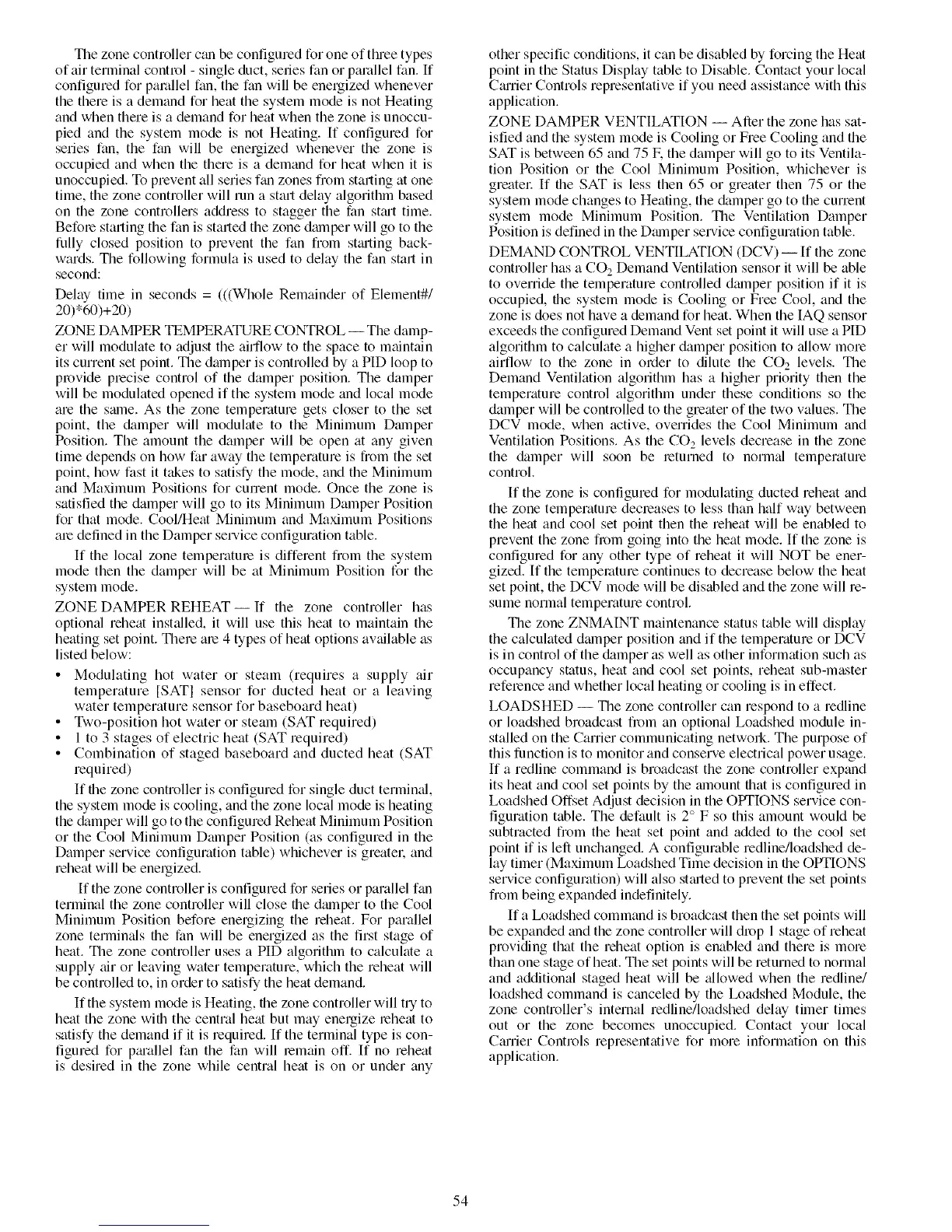